John Peirce
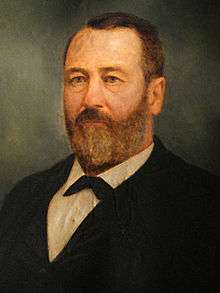
John Peirce (August 16, 1836 – March 3, 1897) was an American professor of chemistry, a scientist and an inventor. He participated in the development of the telephone.
Early life
Peirce was born in Providence, Rhode Island, on August 16, 1836; his father died before he was born. His mother remarried to Seth Padelford, the governor of Rhode Island. Peirce lived with his family in Providence and received his education at the Brown University Grammar School. He graduated in 1856 and worked for a drug company until the poor economic conditions caused by the Panic of 1857 caused him to leave and go with his family to Europe for a year.[1]
Mid life
Although Peirce read law with Abraham Payne in 1859, he never went into practice. He was appointed assistant professor of chemistry in 1862 at Brown University and was promoted to full professorship in 1863. Two years later he resigned and devoted himself to research in chemistry at Harvard University and then Yale University.[1]
Later life
Peirce took care of his personal estate after leaving the universities. He was wealthy and pursued hobbies and studies in his fields of interest, including electricity, photography, and the Aeolian harp.
Telephone innovations
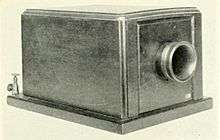
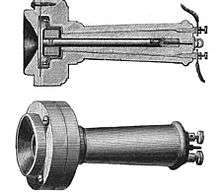
The first telephones consisted of a wooden box which resembled a camera. The mouthpiece was a two-inch tube that had an opening into a cavern air chamber that had in the back a 4.5 inch round plate of sheet iron. This box telephone consisted a large "U" shaped, horseshoe magnet with an iron core attached to each pole. The soft iron core attachments were wound with a spool of small gauge insulated wire. The electrical current generated by the spools of wire related to the waveform of person's voice spoken into the mouthpiece. The whole mechanical gadget was bulky and awkward and did not respond well to a person's voice.[2]
Telephone experiments had been taking place at Brown University in Providence since the fall of 1876. The professors doing these experiments were Peirce, William Francis Channing and Eli Whitney Blake, Jr.[3] By April 1877 they constructed the first portable telephone. This was made of two blocks of wood, one of which had a hole in it for the two inch round converging mouthpiece designed by Peirce.[4] The other block of wood supported a horseshoe magnet made of two toy magnets. It had a sheet metal plate on top that was just touching an iron rod with a spool of small gauge insulated wire to pick up voice sounds. The pattern of electrical currents generated by the spool of wire related to a person's voice spoken into the mouthpiece.[2]
This telephone device weighed about twelve ounces and could be held in one hand when mounted on a handle. It reproduced voices better that the large box telephones made earlier and worked well over long circuits but with less volume. It did, however, serve as both transmitter and receiver and had to be moved from the mouth to the ear depending on whether the caller was speaking or listening.[5] The handle telephone was embraced by Alexander Graham Bell and in June 1878 the Bell Telephone Company began production of its standard handheld model, combined with a wall-hung pushbutton to signal the operator,[6] to sell internationally. The developmental professors at Brown University were given little credit for coming up with this hand-held model.[2] According to the Proceedings of the Rhode Island Historical Society it was Peirce who came up with name "telephone".[7] The wooden telephone set of a transmitter and receiver later became known as the "butterstamp" telephone, due to its resemblance to the wooden dairy butter stamps used at that time for impressing designs onto butter.[1][8]
- widths="180px"
-
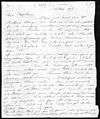
About Bell hearing of Peirce refusing to take out a patent on the converging mouthpiece Peirce developed.
-
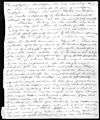
Bell acknowledges that he is indebted to Peirce for the design and form of the telephone mouthpiece.
-

Bell describes the first time he showed the Magnetic Electric Telephone outside his laboratory.
-

Bell explains that the horseshoe magnet is preferable for a small portable telephone and acknowledges Peirce.
Death
Peirce died on March 3, 1897 in Providence.[1]
References
- 1 2 3 4 "Peirce, John". Encyclopedia Brunoniana. Providence RI 02912: Brown University Library. 1993.
When the telephone was being developed, he invented the mouthpiece for the hand telephone, and late in life he experimented with construction of the Aeolian.
- 1 2 3 Prescott 1884, pp. 102–109.
- ↑ United States 1908, p. 156.
- ↑ Prescott 1884, p. 103.
- ↑ Anon. "Telephone receivers with wooden handles, 1877-1902". The Science Musem collection. The Science Museum. Retrieved 22 October 2015.
- ↑ Anon. "1878 Butterstamp". The Phoneboot. The Phonebooth. Retrieved 22 October 2015.
- ↑ Haley, John Williams. "Alexander Graham Bell and Rhode Island". Quahog.org. Retrieved October 13, 2015.
- ↑ "1878 Butterstamp". The Phonebooth. 2015. Retrieved October 12, 2015.
Sources
- Prescott, George Bartlett (1884). Bell's Electric Speaking Telephone: Its Invention, Construction, Application, Modification, and History. D. Appleton.
This little instrument, weighing about twelve ounces and easily held in the hand, especially when mounted on a handle, talked more distinctly than the large instruments, even over long circuits, though not quite so loud. It was followed later in April by a telephone made by Prof. Peirce, in which a small compound U magnet was enclosed in a cubical block of wood, on the top of which he placed for the first time his converging mouth-piece, an acoustic apparatus which deserves special description.
- United States, Suit (1908). The Bell Telephone: The Deposition of Alexander Graham Bell, in the Suit Brought by the United States to Annul the Bell Patents. American Bell Telephone Company.
In the printed publication of your lecture at London, England, before the Society of Telegraph Engineers, October 31, 1877, appeared the following statement; The convenient form of mouth-piece shown, now adopted by me, was invented solely by my friend Professor Peirce.